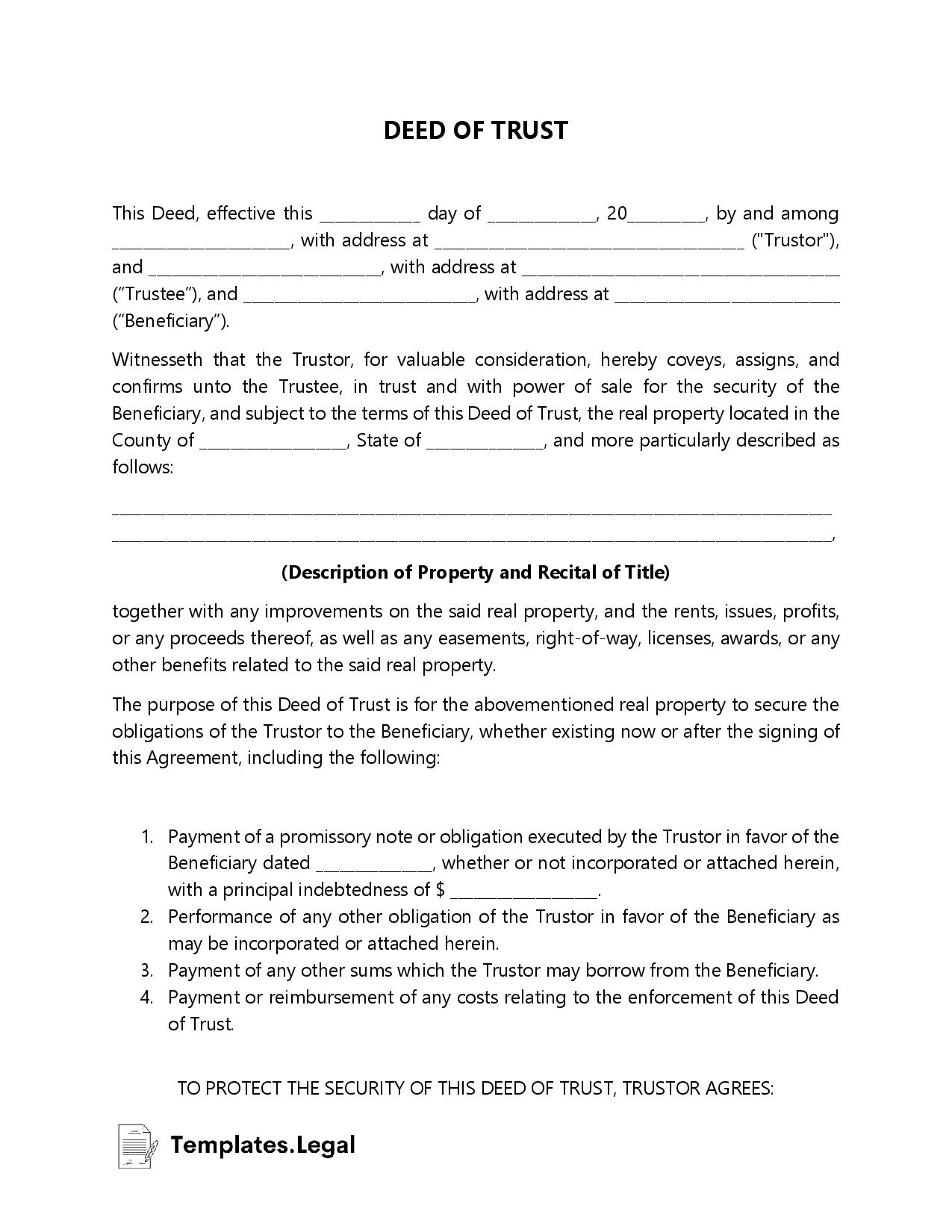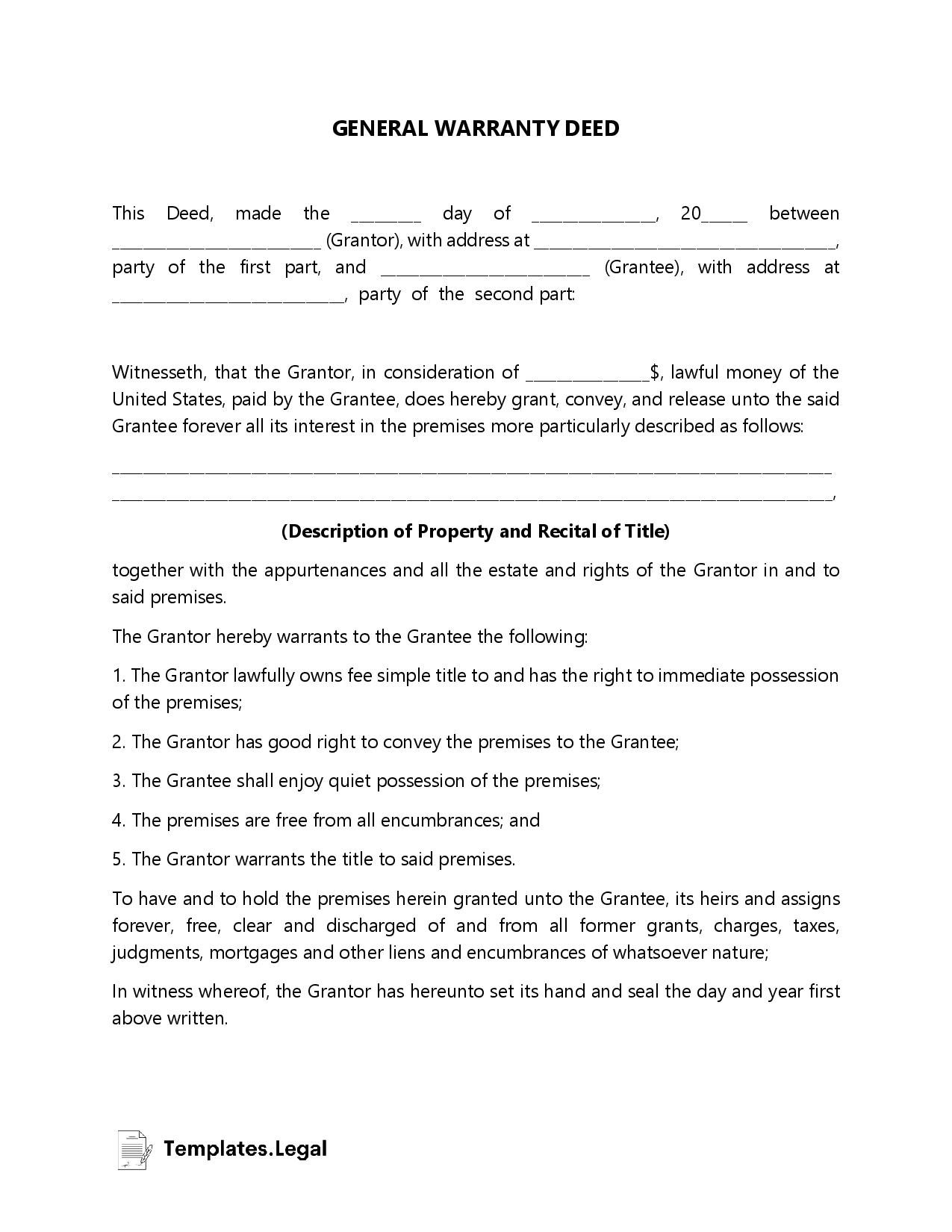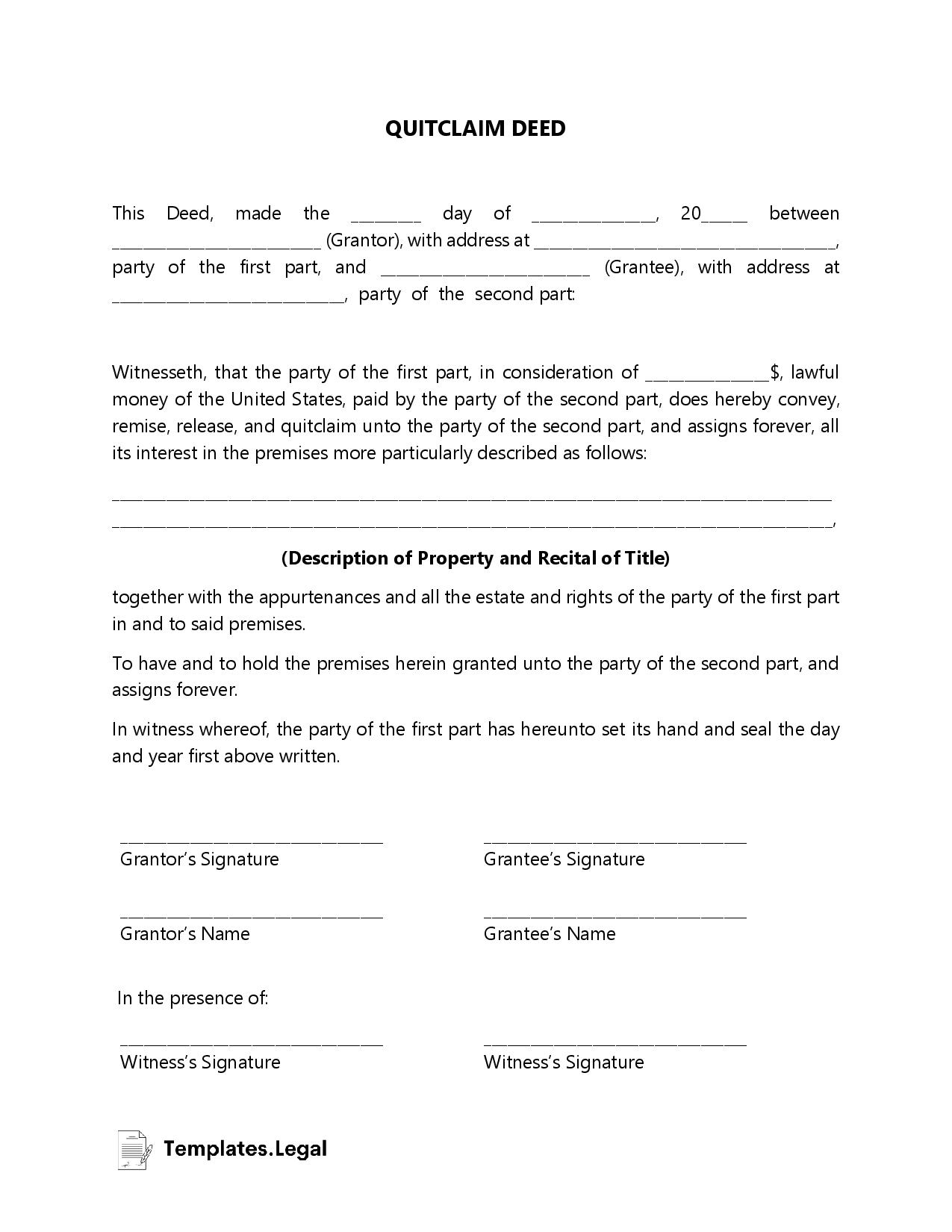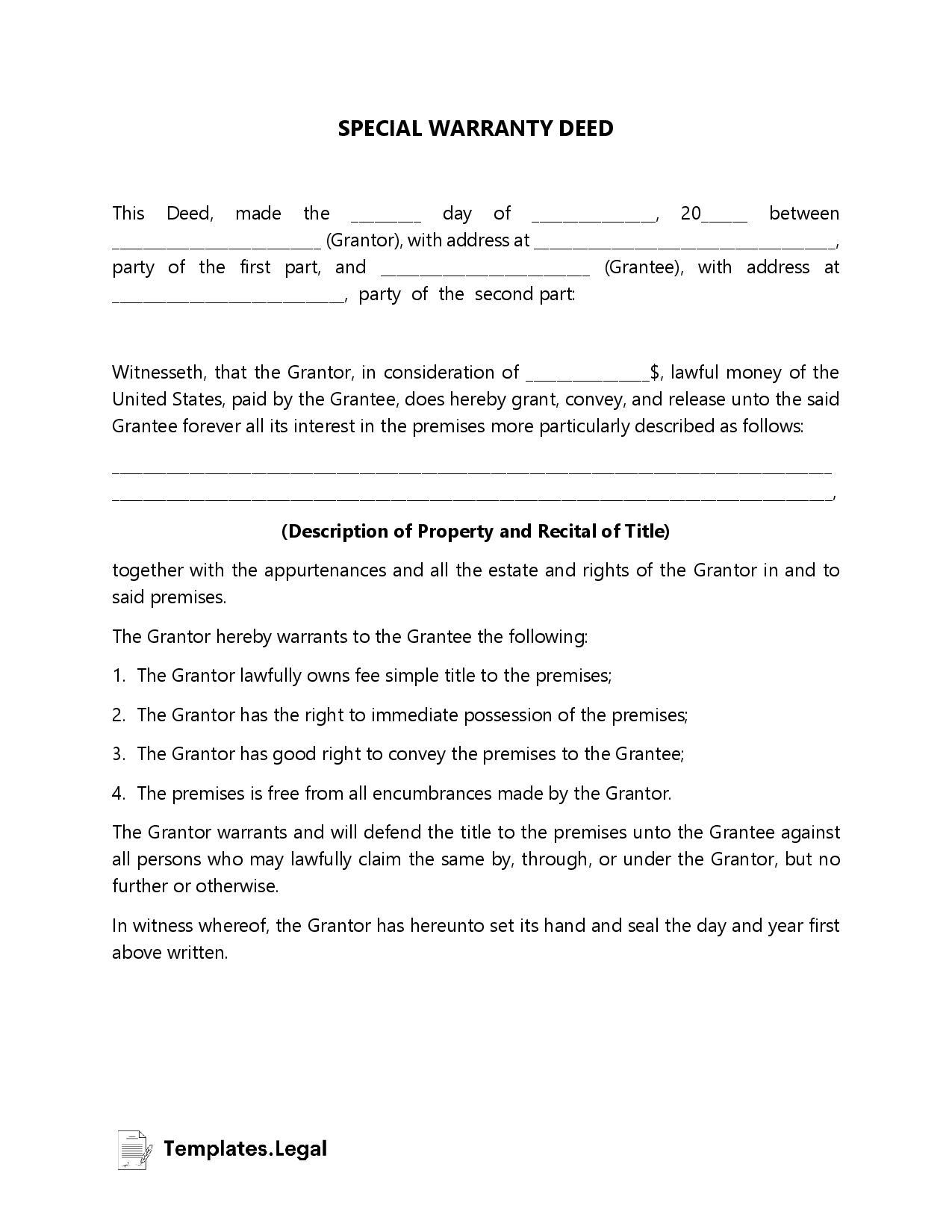Deed Templates & Forms
Transferring a home can be an expensive and stressful time, but using deed forms that are filled out by the parties involved in the transaction can lessen the costs.
Deeds can seem daunting, especially during the first transfer of ownership, but understanding real estate deeds can be straightforward.
What is a Deed Document?
A deed document is a written document that contains all the necessary language and formality to transfer a property from the buyer to the seller, also known as the grantor and grantee, respectively.
A notary public is often required to be present for signing by local legislation. Every state has a different set of requirements for the grantor signing the deed before it is recorded. In states such as Alabama and Kentucky, two witnesses as well as a notary public may be required for signing.
Standing out as more than just a signature, it also features the conditions to which the property will be transferred and is accompanied with taxes that are paid to the clerk upon registering at a Local Registry of Deeds.
Deeds by Type
Aside from the individual types of deeds of which there are four, the actions that bring about the need for the deed can be broadly categorized as official and private.
- Official deeds are brought about because of legal or court mandates.
- Private deeds are due to private transactions and are the most common. Property transfers or transfers where businesses and the public interact are also private deeds.
Deed of Trust
A deed of trust is a secured legal document relating to the purchase of property or real estate that some states use instead of a mortgage agreement. Unlike other deeds which involve two parties, the grantor and grantee, a deed of trust involves a borrower, a trustee, and a third party: the lender.
All three parties are indicated on the deed: the borrower is the purchaser of the home, the lender is often a bank or mortgage company, and the trustee is a title company.
The deed spells out this agreement and the conditions of non-payment. The trustee may place a lien on the property so that if the borrower defaults on their mortgage or requirements, they will be permitted to foreclose and recoup losses.
These types of deeds, such as a house deed, often include a power-of-sale clause which allows the title company to step in a foreclose on the property if the borrower defaults without first obtaining a court order.
In California, all deeds of trust must be filed with the County Recorder’s Office and must be signed in the presence of a notary. Other states will be different.
General Warranty Deed
Also known as a “statutory warranty deed,” a general warranty deed officiates the transfer of a piece of property from one party to another, like the sale of a house. This type of deed offers the grantee the most protection when they purchase the property, and the deed holds a guarantee with the title.
To write a general warranty deed, include the following information as per the state’s laws in the state where the transaction is occurring on the deed forms.
- Purchaser information such as name, role or occupation, and address
- Seller information
- Property information, including physical address
- Past owners of the property, including their names
- Purchase price amount (both written and numerically)
- Mortgages information, if applicable
- Sale dates
- Any covenants imposed upon the buyer from the seller
- Grantor and grantee signatures
- Witness signature (if applicable)
- Notary information and fees paid for registering the deed.
A general warranty deed can be the most appropriate deed for the private transfer of the deed for property for several reasons. A grantor can do it without a lawyer, and it offers the most protection for the grantee.
While it may be done without a lawyer, in states such as North Dakota and Idaho, all deeds should be filed with the County Recorder’s Office and signed with the Grantor in front of a Notary Public.
Quitclaim Deed
If a general warranty deed offers the most protection for the grantee, then a quitclaim deed provides the least. Even less than a special warranty deed because it offers no protection and is a non-warranty deed. This is also the quickest way to transfer property between two parties that trust each other such as family.
With a quitclaim deed, the grantor offers no assurances that they own the deed or the property. Other persons may lay claim to the property, liens, or financial declarations such as mortgages. The grantee must trust the grantor that everything they are promising in the deed is accurate and true.
Situations where it may be advantageous to use a quitclaim deed:
- For the addition of a spouse or partner’s name to the title of a property
- Transfer property to a child, sibling, or another family member
- For transfer property to a Limited Liability Corporation (LLC)
- To bequeath property in a Last Will, which they will receive upon death
In states such as Missouri, Quitclaim deeds must be recorded by the County Recorder of Deeds and signatures viewed by a notary public.
Special Warranty Deed
A special warranty deed has many characteristics in common with a general warranty deed. They are most commonly used for commercial transactions, just as families often use general warranty deeds for private transfers.
A special warranty deed offers less protection for the grantee upon purchase. Only the defects that have occurred under the grantor’s ownership are included in the warranty. Any issues that arise outside of that will not be covered.
A special warranty deed will contain the same information as a general warranty deed; however, it will only guarantee the house deed from the moment of possession until sale. This includes:
- That it is clear from previous claims on the property during the grantor’s possession
- Financial claims on the property such as liens
These deeds are beneficial for circumstances where the property’s previous ownership details cannot be verified or confirmed, such as foreclosure sales. The bank or title holder would only be willing to warranty from the moment they took possession. It’s advised to purchase title insurance for special warranty deeds.
While every state is different, in Maine and Wisconsin, Special Warranty Deeds must be recorded in the Registry of Deeds and acknowledged by a Notary Public or officer of the court.
Deeds by State
How Does a Deed Transfer Work?
A property deed transfers the property and the legal rights of ownership from one party to another. Depending on the type of property transferral and the type of deed required, it may be a relatively short document.
The deed should contain information about the property and associated buildings, including the complete address and information regarding both parties transferring the deed.
A deed transfer can happen with or without a lawyer and often must be recorded by a Recorder’s Office or Clerk of Court, depending on the state.
Both grantor and grantee must be named in the document and information recorded to assure they can be identified in the future. A deed may also contain covenants regarding the transfer.
What are Covenants?
Whether restrictive or conditional, covenants essentially consist of promises that certain activities or financial considerations will or will not happen with the property.
The clauses are legally binding within the deed and could incur fines or recall of the property if not followed. Those relating to the mortgage conditions could allow for the lender or title holder to foreclose on the property if not followed.
These can be affirmative covenants such as maintaining a specific level of insurance that is often required for a mortgage to be acquired or a covenant from the grantor that the property is free of liens when sold to the grantee.
Some jurisdictions assist homeowners with legally removing restrictive and sometimes discriminatory covenants inserted into their deeds during segregation.
How to Write a Deed
Writing a deed can be done using a specialized deed form for the type of deed best suited for the transfer.
While most forms require identifying information for grantor and grantee, others such as special warranty deeds may include specifics about the property’s condition.
After providing the information and agreeing on the arrangement, the deed must be notarized and registered with the correct office according to the state. The online codes for the state will list all the requirements that must be present and detail the necessary signatures for the deed to be legally recognized.
What is a Forced Deed?
A forced, false, or forged deed is not signed by the owner but by a person pretending to be the owner without any legal right of ownership to the property.
False or forged deeds are becoming more and more popular, and the California Department of Real Estate (DRE) has published a guide on what to do if a scammer may have transferred a property through a forced deed.
Specific scams have been associated with forced deeds, such as using a quitclaim deed to quickly transfer property to the scammer without the property owner’s knowledge and obtain a mortgage or loan on the property.
How to Protect Yourself
While most deed transfers will go smoothly, some people want to profit off another person’s loss. To minimize the chances of being taken advantage here are some tips to consider when transferring a deed or using a deed form.
- Always read a deed before signing and ensure that the notary public that witnesses the deed and registers it is legally certified to do so. Contact a titleholder company or local recordings to ensure the property is recorded appropriately.
- Never sign a deed that still has blank spaces or looks like it has been tampered with, even if the other person assures that everything is correct.
- If there is reason to believe something has been done to the property, such as a forged or false deed has been recorded, speak to a state consumer affairs office, department of real estate, or the Notary Public section for your state.
Conclusion
In summary, deeds are physical, legally binding documents that transfer property from one party to another. The documents must contain key information to be legally enforceable, and both parties must agree to the terms, sign the document and have it registered.
Deed forms are available and can be completed without the presence of a lawyer. However, it’s advisable to consult a lawyer before the transaction is finalized to ensure nothing is overlooked and that all conditions are appropriate.
FAQ
Frequently asked questions about deed forms and the types of deeds available.




